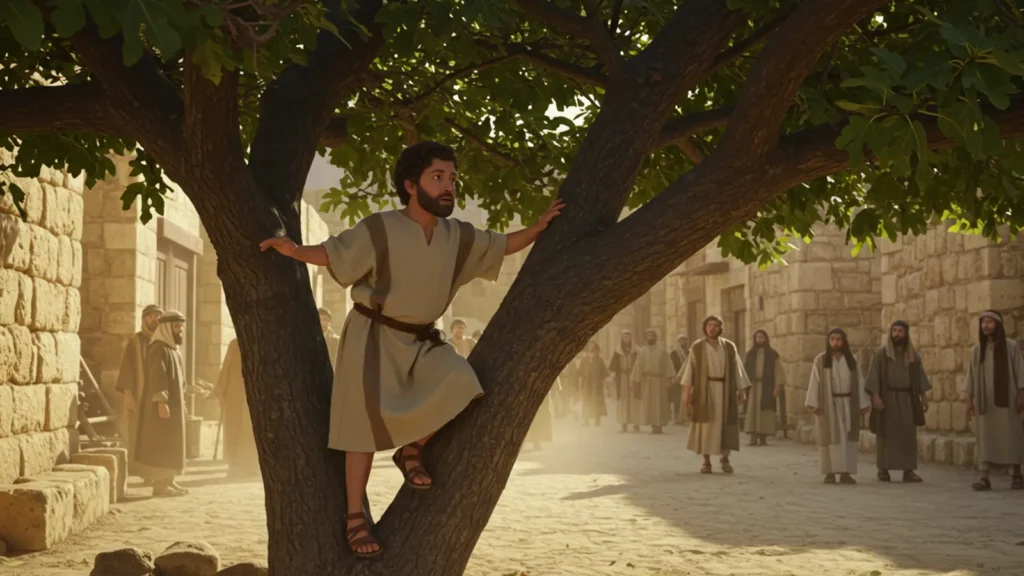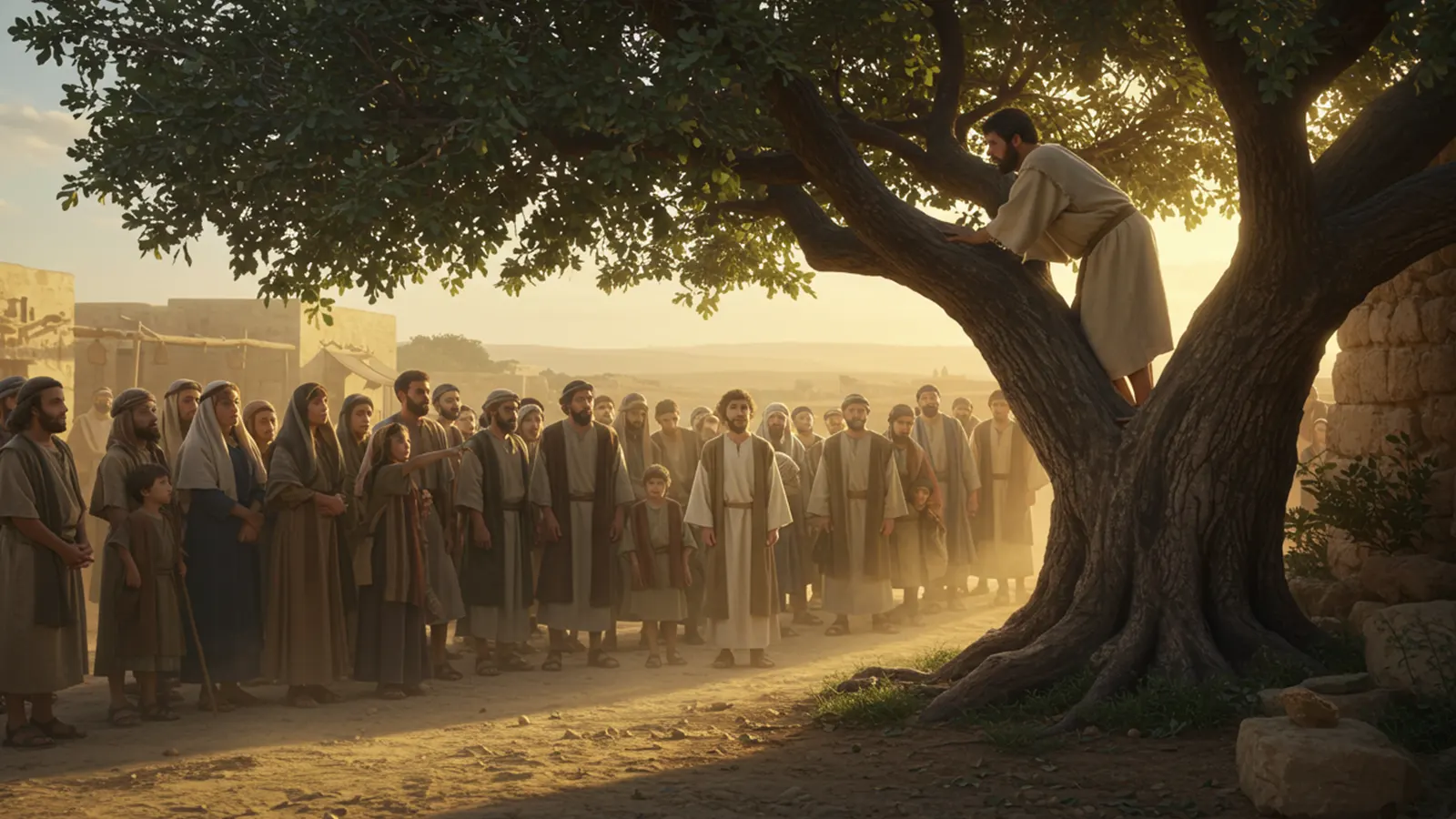The story of Zacchaeus is one of the best-known passages in the New Testament. Told in the Gospel of Luke, it portrays a man who, despite his social position and wealth, longed for something greater: to meet Jesus.
By climbing a tree to see better, Zacchaeus became the central figure of one of the most transformative encounters recorded in Scripture. This episode reveals profound lessons about faith, humility, and a changed life.
Quick Summary
This biblical character’s story is one of the most inspiring accounts in the Gospel. It shows that no one is beyond the reach of grace and that true change happens when repentance is accompanied by concrete actions.
Simply put, here are the key points:
- Origin: he was a tax collector from Jericho, viewed as unjust and rejected by society.
- Search: despite limitations, he did everything he could to see Jesus, showing a sincere desire to change.
- Calling: he was called by name and received a visit from the Master in his home.
- Transformation: he decided to make amends, return ill-gotten goods, and help the poor.
- Legacy: he became a symbol of genuine repentance and a reminder that there’s always a chance to start over.
This overview helps explain why his story remains so striking. The account blends social context, personal action, and divine intervention, offering a message that spans generations: the possibility of a fresh start is open to all.
The Historical Context of Zacchaeus
Zacchaeus lived in Jericho, an important city on the trade route of the time. He was the chief of the publicans—tax collectors who worked for the Roman Empire. Because of this, he was considered a sinner and was poorly regarded by the population. His wealth often came from unjust practices, but his encounter with Jesus completely changed that reality.
The Meaning of Being a Publican
Tax collectors were known for exploitation and abusive charges. Holding the position of chief tax collector, like Zacchaeus, meant having power and money—and at the same time, the community’s disdain. This detail makes his decision to seek Jesus even more impressive, as it shows a sincere desire for transformation.

Zacchaeus’ Encounter with Jesus
The central moment of the story is when Jesus passes through Jericho and Zacchaeus, being short in stature, climbs a wild fig tree to see Him. This attitude shows his determination and courage to face criticism just so he wouldn’t miss the opportunity to meet the Master.
Jesus’ Reaction
When He saw Zacchaeus, Jesus called him by name and declared He would stay at his house. This caused surprise and even indignation among the townspeople, who could not understand how the Master could approach someone so rejected. Yet this gesture revealed God’s love, which does not look at appearances but at the heart.
Zacchaeus’ Transformation
Upon receiving Jesus in his home, Zacchaeus made a radical decision: to return four times what he had wrongfully taken and to give half of his possessions to the poor. This was not merely an act of generosity, but solid proof of repentance and a changed life.
Spiritual Lessons from Zacchaeus’ Story
Zacchaeus’ narrative goes beyond a simple historical episode. It brings valuable teachings for anyone seeking spiritual transformation.
Faith and Perseverance
Even facing physical and social limitations, Zacchaeus did not give up. His faith and desire to see Jesus led him to act boldly, serving as inspiration for those who face barriers on the journey of faith.
God’s Personal Call
Jesus called Zacchaeus by name, demonstrating that the divine relationship is personal and unique. This message reinforces that each person is known and loved by God in a singular way.
True Wealth
Before, Zacchaeus valued money and power. After meeting Jesus, he discovered that true wealth lies in living with integrity and sharing with those in need. His change highlights the importance of prioritizing eternal values.

The Symbolism of Zacchaeus’ Tree
The tree Zacchaeus climbed became a symbol of spiritual seeking. It represents the willingness to step out of one’s comfort zone to see beyond the visible. This detail shows that small actions can open the way for great encounters.
Zacchaeus and Salvation
Jesus’ statement is striking:
“Today salvation has come to this house.”
This announcement was not limited to Zacchaeus but reached his family, showing that one person’s decision can impact generations. Thus, salvation is manifested through faith and a transformed heart.
Curiosities about the Story and Tradition
Beyond its spiritual importance, this biblical character’s narrative has also generated various traditions and interpretations over the centuries. Many are little known, but they help us understand how his figure has crossed generations.
- Origin of the name: some scholars suggest the name may have roots in Hebrew with a meaning related to purity or justice, which contrasts with his earlier life marked by injustice.
- Presence in art: medieval stained-glass windows in European cathedrals depict the fig-tree scene, symbolizing the quest for spiritual vision.
- Sacred theater: in the Middle Ages, religious plays depicted his story to teach illiterate people about repentance and salvation.
- Missionary use: missionaries in different eras cited the episode as an example that no one is beyond the reach of God’s love, especially in regions where they sought to reach people considered far from faith.
- Influence on popular songs: in some Christian communities, children’s songs arose that simplify the story to teach values of humility and transformation to kids.
These curiosities show how the narrative surpassed biblical boundaries and became part of Christian cultural memory, reinforcing its relevance not only for theological studies but also for the identity of faith across various traditions.
Zacchaeus in Christian Tradition
The memory of this biblical character has spanned centuries as one of the strongest examples of spiritual transformation. In different Christian contexts, his story has been used to teach, inspire, and encourage believers to seek a renewed life.
In ancient sermons, his narrative was presented as proof that conversion is not merely a change in speech but in practical attitudes. This idea became one of the foundations of pastoral preaching, reinforcing that true faith must be accompanied by visible fruit.
Moreover, his figure gained prominence in songs, hymns, and liturgical chants that are still remembered in services and gatherings of faith. In these compositions, the central message has always been the same: even those rejected by society can be welcomed by divine love.
To make clearer how this tradition developed, here are some examples of how the story has been remembered over time:
- In sermons: used to highlight the need for true repentance.
- In music: inspiration for hymns about forgiveness and grace.
- In sacred art: portrayed in paintings, stained glass, and even religious plays.
- In Bible studies: analyzed as a practical case of Jesus’ message about inclusion and salvation.
- In catechesis: taught to children and youth as an example of change and a fresh start.
This steady presence shows how his life became a powerful pedagogical and spiritual resource, reminding Christians that no one is beyond the reach of mercy. The episode has crossed the centuries precisely because it conveys a universal hope: the possibility of starting over and living with integrity is always open.
Practical Reflections for Life
The story of Zacchaeus invites us to reflect on several points applicable to daily life:
- Be willing to overcome obstacles to draw closer to God.
- Acknowledge wrongs and seek to make amends.
- Understand that faith requires concrete actions.
- Value relationships more than riches.
- Recognize that each encounter with the sacred can transform lives.
Frequently Asked Questions about Zacchaeus
Who was Zacchaeus in the Bible?
Zacchaeus was the chief of the tax collectors in Jericho. His story is recorded in the Gospel of Luke, chapter 19.
Why did Zacchaeus climb the tree?
Because he was short and could not see Jesus amid the crowd, he climbed a fig tree to get a better view.
What did Zacchaeus do after meeting Jesus?
He promised to give half of his goods to the poor and to return fourfold everything he had taken unjustly.
What do we learn from Zacchaeus’ story?
We learn about faith, repentance, generosity, and God’s personal love for each individual.
Where is Zacchaeus’ account in the Bible?
The episode is in the Gospel of Luke, chapter 19, verses 1–10.
Conclusion
The story of Zacchaeus is an invitation to transformation. A man rejected by society found in Jesus not condemnation but acceptance and the opportunity to start over. His life was marked by genuine repentance and practical acts of generosity. This narrative shows that no one is too far to be reached by grace, and that a simple act of faith can change entire destinies.
Glossary of Important Terms
To make reading clearer, see below the meaning of some words that might raise questions:
- Tax collector: a collector of taxes who worked for the Roman Empire, often rejected by the people.
- Wild fig tree: a tree with a low trunk and wide branches, common in the region of Palestine. It produced fruit of little use for food but was used for shade and climbing. For this reason, it served as the perfect support for the biblical character to climb and gain a better view of the crowd.
- Liturgical: related to practices and chants used in worship services or religious celebrations.
- Catechesis: basic teaching of the Christian faith, generally aimed at children, youth, or new converts.
READ ALSO:
- Romans 11:36: All Things Are From Him, Through Him, and For Him
- Act of Contrition: Understand, Learn, and Practice
- Psalm 135: Celebration of God’s Sovereignty and Faithfulness
FOLLOW US ON FACEBOOK